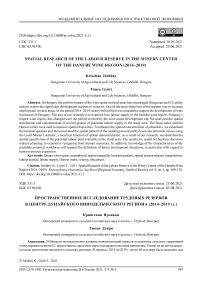Spatial research of the labour reserve in the winery center of the Danube wine region (2014-2019)
Автор: Jrdny Krisztin, Gyri Tmea
Журнал: Региональная экономика. Юг России @re-volsu
Рубрика: Фундаментальные исследования пространственной экономики
Статья в выпуске: 4 т.9, 2021 года.
Бесплатный доступ
In Hungary, the positive impact of the wine sector on rural areas has encouraged Hungarian and EU policy makers to provide significant development support to wineries. One of the main objectives of the support was to increase employment in rural areas. In the period 2014-2019, nearly €60 million was awarded to support the development of wine businesses in Hungary. The aim of our research is to examine how labour supply in the Danube wine region, Hungary’s largest wine region, has changed over the period covered by the wine sector development aid. We analysed the spatial distribution and concentration of several groups of potential labour supply in the study area. The Dual-index and the Hoover-index were used to measure spatial disparities. To measure the spatial concentration of jobseekers, we calculated the location quotient and then examined the spatial pattern of the resulting municipality-level concentration values using the Local Moran I statistic, a local test function of spatial autocorrelation. As a result of our research, we identified the spatial specificities of the potential labour pool available in the study area. The results are useful for business decision-makers planning to expand or reorganise their human resources. In addition, knowledge of the characteristics of the available potential workforce will support the definition of future development directions, in particular with regard to human resource expansion.
Donau wine region, unemployed, spatial inequality, location quotient, spatial autocorrelation, interpolation, labour market, labour supply, hoover index, winery, viticulture
Короткий адрес: https://sciup.org/149139588
IDR: 149139588 | DOI: 10.15688/re.volsu.2021.4.11
Список литературы Spatial research of the labour reserve in the winery center of the Danube wine region (2014-2019)
- Anselin L., 1995. Local Indicators of Spatial Association – LISA. Geographical Analysis, vol. 27 (2), pp. 93-115. DOI: https://doi.org/10.1111/j.1538-4632.1995.tb00338.x.
- Bálint L., 2011. A születéskor várható élettartam nemek szerinti térbeli különbségei. Területi Statisztika, no. 51 (4), pp. 386-404. URL: http://www.ksh.hu/docs/hun/xftp/terstat/2011/04/balint.pdf.
- Bartier P.M., Keller C.P., 1996. Multivariate Interpolation to Incorporate Thematic Surface Data Using Invesre Distance Weighting (IDW). Computers and Geosciences, vol. 22, pp. 795-799.
- Egri Z., 2017. Magyarország városai közötti egészségegyenlőtlenségek. Területi Statisztika, vol. 57 (5), pp. 537-575. DOI: 10.15196/TS570504.
- Gál P., 2020. A földrajzi árujelzők szerepe a magyar borpiacon. Statisztikai szemle, vol. 98 (3), pp. 242-267. DOI: 10.20311/stat2020.3.hu0242.
- Getis-J. K., Getis A., 1996. Local Spatial Autocorrelation Statistics: Distributional Issues and an Application. Geographical Analysism, vol. 27, no. 4, pp. 286-306. DOI: https://doi.org/10.1111/j.1538-4632.1995.tb00912.x.
- Győri T., Egri Z., 2020. A munkanélküliek – mint potenciális munkaerő-tartalék – térszerkezetének vizsgálata Békés megyében. Studia Mundi – Economica, no. 7 (2), pp. 2-17. DOI: 10.18531/Studia.Mundi.2020. 07.02.2-17.
- Hajdú D., 2020. A munkanélküliség és felnőttképzés területi eloszlása az Észak-magyarországi régióban. Északmagyarországi stratégiai füzetek, no. 17 (2), pp. 62-69. DOI: 10.32976/stratfuz.2020.14.
- Járdány K., 2021. A Duna borrégió szőlészeti és borászati helyzetének vizsgálata a magyar szőlő-bor ágazatban. Studia Mundi – Economica, no. 8 (1), pp. 49-64. DOI: 10.18531/Studia.Mundi.2021.08.01.49-64.
- Juhász B., 2020. A Vajdasági Gazdaságfejlesztési Program előzményei, megvalósulása és eredményei. Studia Mundi – Economica, no. 7 (1), pp. 12-25. DOI: 10.18531/Studia.Mundi.2021.08.01.49-64.
- Káposzta J., 2016. Regionális összefüggések a vidékgazdaság fejlesztésében. Studia Mundi – Economica, no. 3 (1), pp. 52-61. DOI: 10.18531/Studia.Mundi.2016.03.01.52-61.
- Keszthelyi K., 2019. Az Új Magyarország Vidékfejlesztési Program területi hatásai. Studia Mundi – Economica, no. 6 (3), pp. 29-41. DOI: 10.18531/Studia.Mundi.2019.06.03.29-41.
- Kincses Á., Valkó G., Bóday P., Lengyel Gy., 2013. Szomszédsági hatások a magyar mezőgazdaságban. Területi Statisztika, no. 53 (2), pp. 157-168. URL: http://www.ksh.hu/docs/hun/xftp/terstat/2013/02/ts2013_02_05.pdf?lang=hu.
- Kispál G., 2017. Examination of Adapting the Contractual System in the Hungarian Wine Sector. Annals of the Polish Association of Agricultural and Agribusiness Economists, no. 19 (2), pp. 108-113. DOI: 10.22004/ag.econ.293501.
- Kiss J.P., Németh N., 2006. Fejlettség és egyenlőtlenségek – Magyarország megyéinek és kistérségeinek esete. Budapest, “Ěagyar Tudományos Akadémia Közgazdaságtudományi Intézet” Publ. 40 p. URL: http://www.econ.core.hu/doc/bwp/bwp/bwp0608. pdf.
- Meloni G., Swinnen J., 2013. The Political Economy of European Wine Regulations. Journal of Wine Economics, no. 8 (3), pp. 244-284. DOI: 10.1017/jwe.2013.33.
- Meng Q., Liu Z., Borders B.E., 2013. Assessment of Regression Kriging for Spatial Interpolation – Comparisons of Seven GIS Interpolation Methods. Cartography and Geographic Information Science, vol. 40, no. 1, pp. 28-39. DOI: https://doi.org/10.1080/15230406.2013.762138.
- Sidlovits D., 2008. Vertikális koordináció a szőlő- és borágazatban. PhD értekezés. Budapest, Budapesti Corvinus Egyetem Interdiszciplináris Doktori Iskola Publ. 163 p.
- Tobler W.R., 1970. A Computer Movie Simulating Urban Growth in the Detroit Region. Economic Geography, no. 46, pp. 234-240.
- Tóth G., 2014. Térinformatika a gyakorlatban közgazdászoknak. Miskolc, Miskolci Egyetemi
- Kiadó Publ. 107 p. URL: https://gtk.uni-miskolc.hu/files/6405/Terinfo.pdf.


